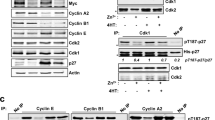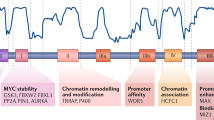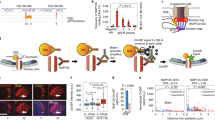Abstract
c-Myc coordinates cell growth and division through a transcriptional programme that involves both RNA polymerase (Pol) II- and Pol III-transcribed genes. Here, we demonstrate that human c-Myc also directly enhances Pol I transcription of ribosomal RNA (rRNA) genes. rRNA synthesis and accumulation occurs rapidly following activation of a conditional MYC-ER allele (coding for a Myc–oestrogen-receptor fusion protein), is resistant to inhibition of Pol II transcription and is markedly reduced by c-MYC RNA interference. Furthermore, by using combined immunofluorescence and rRNA-FISH, we have detected endogenous c-Myc in nucleoli at sites of active ribosomal DNA (rDNA) transcription. Our data also show that c-Myc binds to specific consensus elements located in human rDNA and associates with the Pol I-specific factor SL1. The presence of c-Myc at specific sites on rDNA coincides with the recruitment of SL1 to the rDNA promoter and with increased histone acetylation. We propose that stimulation of rRNA synthesis by c-Myc is a key pathway driving cell growth and tumorigenesis.
This is a preview of subscription content, access via your institution
Access options
Subscribe to this journal
Receive 12 print issues and online access
$209.00 per year
only $17.42 per issue
Buy this article
- Purchase on Springer Link
- Instant access to full article PDF
Prices may be subject to local taxes which are calculated during checkout





Similar content being viewed by others
References
Grummt, I. Life on a planet of its own: regulation of RNA polymerase I transcription in the nucleolus. Genes Dev. 17, 1691–1702 (2003).
Dang, C. V. c-Myc target genes involved in cell growth, apoptosis, and metabolism. Mol. Cell. Biol. 19, 1–11 (1999).
Grandori, C., Cowley, S. M., James, L. P. & Eisenman, R. N. The Myc/Max/Mad network and the transcriptional control of cell behavior. Annu. Rev. Cell. Dev. Biol. 16, 653–699 (2000).
Lutz, W., Leon, J. & Eilers, M. Contributions of Myc to tumorigenesis. Biochim. Biophys. Acta 1602, 61–71 (2002).
Eilers, M., Picard, D., Yamamoto, K. R. & Bishop, J. M. Chimaeras of myc oncoprotein and steroid receptors cause hormone-dependent transformation of cells. Nature 340, 66–68 (1989).
Johnston, L. A., Prober, D. A., Edgar, B. A., Eisenman, R. N. & Gallant, P. Drosophila myc regulates cellular growth during development. Cell 98, 779–790 (1999).
Trumpp, A. et al. c-Myc regulates mammalian body size by controlling cell number but not cell size. Nature 414, 768–773 (2001).
Knoepfler, P. S., Cheng, P. F. & Eisenman, R. N. N-myc is essential during neurogenesis for the rapid expansion of progenitor cell populations and the inhibition of neuronal differentiation. Genes Dev. 16, 2699–2712 (2002).
Mateyak, M. K., Obaya, A. J., Adachi, S. & Sedivy, J. M. Phenotypes of c-Myc-deficient rat fibroblasts isolated by targeted homologous recombination. Cell Growth Differ. 8, 1039–1048 (1997).
Iritani, B. M. & Eisenman, R. N. c-Myc enhances protein synthesis and cell size during B lymphocyte development. Proc. Natl Acad. Sci. USA 96, 13180–13185 (1999).
Schuhmacher, M. et al. Control of cell growth by c-Myc in the absence of cell division. Curr. Biol. 9, 1255–1258 (1999).
Pierce, S.B. et al. dMyc is required for larval growth and endoreplication in Drosophila. Development 131, 2317–2327 (2004).
Coller, H. A. et al. Expression analysis with oligonucleotide microarrays reveals that Myc regulates genes involved in growth, cell cycle, signaling, and adhesion. Proc. Natl Acad. Sci. USA 97, 3260–3265 (2000).
Guo, Q. M. et al. Identification of c-myc responsive genes using rat cDNA microarray. Cancer Res. 60, 5922–5928 (2000).
Boon, K. et al. N-myc enhances the expression of a large set of genes functioning in ribosome biogenesis and protein synthesis. EMBO J. 20, 1383–1393 (2001).
Shiio, Y. et al. Quantitative proteomic analysis of Myc oncoprotein function. EMBO J. 21, 5088–5096 (2002).
Orian, A. et al. Genomic binding by the Drosophila Myc, Max, Mad/Mnt transcription factor network. Genes Dev. 17, 1101–1114 (2003).
Fernandez, P. C. et al. Genomic targets of the human c-Myc protein. Genes Dev. 17, 1115–1129 (2003).
Gomez-Roman, N., Grandori, C., Eisenman, R. N. & White, R. J. Direct activation of RNA polymerase III transcription by c-Myc. Nature 421, 290–294 (2003).
Grandori, C., Mac, J., Siebelt, F., Ayer, D. E. & Eisenman, R. N. Myc–Max heterodimers activate a DEAD box gene and interact with multiple E box-related sites in vivo. EMBO J. 15, 4344–4357 (1996).
Littlewood, T. D., Hancock, D. C., Danielian, P. S., Parker, M. G. & Evan, G. I. A modified oestrogen receptor ligand-binding domain as an improved switch for the regulation of heterologous proteins. Nucleic Acids Res. 23, 1686–1690 (1995).
Gonzalez, I. L. & Sylvester, J. E. Complete sequence of the 43-kb human ribosomal DNA repeat: analysis of the intergenic spacer. Genomics 27, 320–328 (1995).
Arabi, A., Rustum, C., Hallberg, E. & Wright, A. P. Accumulation of c-Myc and proteasomes at the nucleoli of cells containing elevated c-Myc protein levels. J. Cell Sci. 116, 1707–1717 (2003).
O'Sullivan, A. C., Sullivan, G. J. & McStay, B. UBF binding in vivo is not restricted to regulatory sequences within the vertebrate ribosomal DNA repeat. Mol. Cell. Biol. 22, 657–668 (2002).
McMahon, S. B., Wood, M. A. & Cole, M. D. The essential cofactor TRRAP recruits the histone acetyltransferase hGCN5 to c-Myc. Mol. Cell. Biol. 20, 556–562 (2000).
Schlosser, I. et al. A role for c-Myc in the regulation of ribosomal RNA processing. Nucleic Acids Res. 31, 6148–6156 (2003).
Poortinga, G. et al. MAD1 and c-Myc regulate UBF and rDNA transcription during granulocyte differentiation. EMBO J. 23, 3325–3335 (2004).
von der Lehr, N. et al. The F-box protein Skp2 participates in c-Myc proteosomal degradation and acts as a cofactor for c-Myc-regulated transcription. Mol. Cell 11, 1189–1200 (2003).
Welcker, M. et al. The Fbw7 tumor suppressor regulates glycogen synthase kinase 3 phosphorylation-dependent c-Myc protein degradation. Proc. Natl Acad. Sci. USA 101, 9085–9090 (2004).
Welcker, M., Orian, A., Grim, J. A., Eisenman, R. N. & Clurman, B. E. A nucleolar isoform of the Fbw7 ubiquitin ligase regulates c-Myc and cell size. Curr. Biol. 14, 1852–1857 (2004).
Nair, S. K. & Burley, S. K. X-ray structures of Myc-Max and Mad-Max recognizing DNA. Molecular bases of regulation by proto-oncogenic transcription factors. Cell 112, 193–205 (2003).
Kulkens, T., van der Sande, C. A., Dekker, A. F., van Heerikhuizen, H. & Planta, R. J. A system to study transcription by yeast RNA polymerase I within the chromosomal context: functional analysis of the ribosomal DNA enhancer and the RBP1/REB1 binding sites. EMBO J. 11, 4665–4674 (1992).
White, R. J. RNA Polymerase I and III, growth control and cancer. Nature Rev. Mol. Cell Biol. 6, 69–79 (2005).
Acknowledgements
We thank L. Comai and J. Flint for generous gifts of antibodies and A. Burdick and K. Robinson for technical assistance; J. Benanti, M. Welcker and B. Moorefield for critical reading of the manuscript; T. Ragoczy, S. Kosak, M. Lorincz and D. Dickerson in the Groudine laboratory for advice on FISH and run-on assays; T. Sawado for the ChIP protocol; and the Fred Hutchinson Image Analysis staff for help with DeltaVision microscopy. We are also grateful to R. Reeder for helpful discussions during the course of this work. Support for this work was from National Institutes of Health grants to C.G. D.A.G. and R.N.E.; and Cancer Research UK grants to R.J.W. R.N.E. is an American Cancer Society Research professor.
Author information
Authors and Affiliations
Corresponding author
Ethics declarations
Competing interests
The authors declare no competing financial interests.
Supplementary information
Supplementary Information
Supplementary figures S1, S2, and S3, supplementary table S1 and movie legends (PDF 351 kb)
Rights and permissions
About this article
Cite this article
Grandori, C., Gomez-Roman, N., Felton-Edkins, Z. et al. c-Myc binds to human ribosomal DNA and stimulates transcription of rRNA genes by RNA polymerase I. Nat Cell Biol 7, 311–318 (2005). https://doi.org/10.1038/ncb1224
Published:
Issue Date:
DOI: https://doi.org/10.1038/ncb1224
This article is cited by
-
Ribosome biogenesis in disease: new players and therapeutic targets
Signal Transduction and Targeted Therapy (2023)
-
RUNX3 inactivates oncogenic MYC through disruption of MYC/MAX complex and subsequent recruitment of GSK3β-FBXW7 cascade
Communications Biology (2023)
-
Altered vitamin B12 metabolism in the central nervous system is associated with the modification of ribosomal gene expression: new insights from comparative RNA dataset analysis
Functional & Integrative Genomics (2023)
-
MYC sensitises cells to apoptosis by driving energetic demand
Nature Communications (2022)
-
Codon optimality in cancer
Oncogene (2021)



